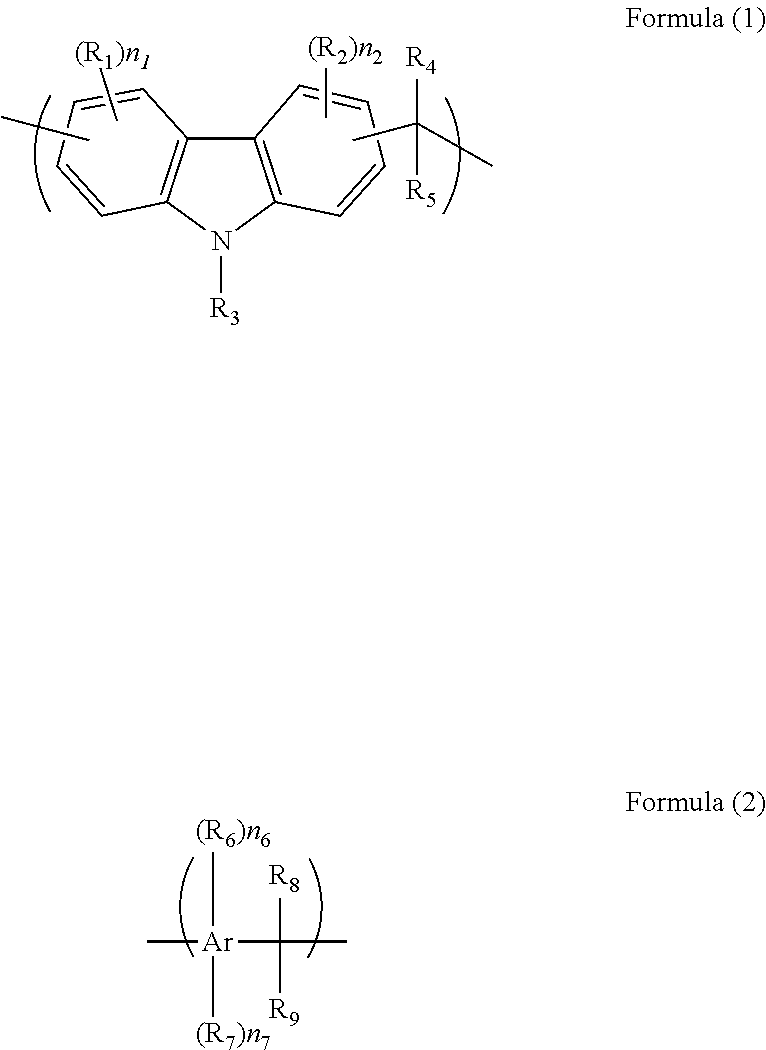Composition for forming a resist underlayer film including hydroxyl group-containing carbazole novolac resin
a technology of hydroxyl group and hydroxyl group, which is applied in the direction of instruments, photomechanical equipment, and semiconductor/solid-state device details, etc., can solve the problems of standing waves and diffuse reflection, difficult to achieve sufficient resist pattern thickness for substrate processing, and accompanied shift to shorter wavelengths. , to achieve the effect of efficient suppression of reflection from the substrate, high heat resistance and good precision
- Summary
- Abstract
- Description
- Claims
- Application Information
AI Technical Summary
Benefits of technology
Problems solved by technology
Method used
Image
Examples
synthesis example 1
[0108]Into a 200 ml three-necked flask, 8.36 g of carbazole (by Tokyo Chemical Industry), 7.21 g of 1-naphthol (by Tokyo Chemical Industry), 15.62 g of 1-naphthoaldehyde (by Tokyo Chemical Industry), 124.75 g of toluene (by Kanto Chemical) and 0.48 g of p-toluenesulfonic acid monohydrate (by Tokyo Chemical Industry) were charged. Thereafter, the interior of the flask was purged with nitrogen, and then the flask was heated up to 130° C., with stirring under reflux for about 9 hours. After the reaction was over, the product was diluted with 31.14 g of tetrahydrofuran (by Kanto Chemical), and the precipitate was removed by filtration. The recovered filtrate was dripped onto a mixed solution of methanol / 28% aqueous ammonia (389 g / 3 g), to elicit re-precipitation. The obtained precipitate was suction-filtered, and the filtered product was dried under reduced pressure overnight at 85° C. There were obtained 17.45 g of a beige powder of a carbazole resin. The obtained polymer corresponded ...
synthesis example 2
[0109]Into a 200 ml three-necked flask, 11.70 g of carbazole (by Tokyo Chemical Industry), 4.32 g of 1-naphthol (by Tokyo Chemical Industry), 15.62 g of 1-naphthoaldehyde (by Tokyo Chemical Industry), 124.75 g of toluene (by Kanto Chemical) and 0.48 g of p-toluenesulfonic acid monohydrate (by Tokyo Chemical Industry) were charged. Thereafter, the interior of the flask was purged with nitrogen, and then the flask was heated up to 130° C., with stirring under reflux for about 9 hours. After the reaction was over, the product was diluted with 32.06 g of tetrahydrofuran (by Kanto Chemical), and the precipitate was removed by filtration. The recovered filtrate was dripped onto a mixed solution of methanol / 28% aqueous ammonia (400 g / 3 g), to elicit re-precipitation. The obtained precipitate was suction-filtered, and the filtered product was dried under reduced pressure overnight at 85° C. There were obtained 17.32 g of a beige powder of a carbazole resin. The obtained polymer corresponded...
synthesis example 3
[0110]Into a 200 ml three-necked flask, 5.18 g of carbazole (by Tokyo Chemical Industry), 10.43 g of 1-naphthol (by Tokyo Chemical Industry), 16.14 g of 1-naphthoaldehyde (by Tokyo Chemical Industry), 127.00 g of toluene (by Kanto Chemical) and 0.49 g of p-toluenesulfonic acid monohydrate (by Tokyo Chemical Industry) were charged. Thereafter, the interior of the flask was purged with nitrogen, and then the flask was heated up to 130° C., with stirring under reflux for about 8 hours. After the reaction was over, the product was diluted with 31.22 g of tetrahydrofuran (by Kanto Chemical), and the precipitate was removed by filtration. The recovered filtrate was dripped onto a mixed solution of methanol / 28% aqueous ammonia (390 g / 3 g), to elicit re-precipitation. The obtained precipitate was suction-filtered, and the filtered product was dried under reduced pressure overnight at 85° C. There were obtained 9.24 g of a brown powder of a carbazole resin. The obtained polymer corresponded ...
PUM
| Property | Measurement | Unit |
|---|---|---|
| molar ratio | aaaaa | aaaaa |
| molar ratio | aaaaa | aaaaa |
| wavelength | aaaaa | aaaaa |
Abstract
Description
Claims
Application Information
 Login to View More
Login to View More - R&D
- Intellectual Property
- Life Sciences
- Materials
- Tech Scout
- Unparalleled Data Quality
- Higher Quality Content
- 60% Fewer Hallucinations
Browse by: Latest US Patents, China's latest patents, Technical Efficacy Thesaurus, Application Domain, Technology Topic, Popular Technical Reports.
© 2025 PatSnap. All rights reserved.Legal|Privacy policy|Modern Slavery Act Transparency Statement|Sitemap|About US| Contact US: help@patsnap.com



